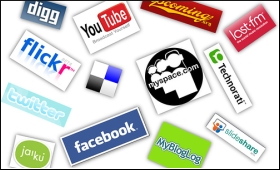|

|
Social media adoption by SMEs
|
|

|
|
| Top Stories |
 |
|
|
|
Sirjjan Preet | 23 Jul, 2012
Social media in India is growing at 100% and by 2014, 129.3 million Indians are expected to join the social media forums. According to eMarketer, fastest growth in social networking this year will come from India, followed by Indonesia and China. With an increasing number of users registering on social media websites, Small and Medium Enterprises (SMEs) can successfully use social media platforms to promote their business. Despite the fact that social networking sites now reach 82% of the world's online population and social networking is the most popular online activity worldwide, SMEs are not capitalising on it.
It is true not only in India but even in the US where nearly half of the population is engaged with social networking yet as per a survey by Zoomerang, one out of every two small businesses in the US don't have a strong social media presence. Similarly in Australia which has the social network penetration rate of 44.4%, only 34% of medium and 27% of small businesses are plugging into social media (Australian Interactive Media Industry Association). So why is social media still a scary prospect for SMEs?
Primarily the fear of losing control over sensitive information hinders social media adoption among SMEs. It is like putting part of the message in the hands of customers, which may go the wrong way. The fact is that not every business is going to be able to use social media in the same way. So before engaging in social media marketing, SMEs need to gain clarity about what they are trying to promote? What is their Unique Selling Proposition (USP)? And who is the target audience? It is imperative that they do a Target Audience Profiling (TAP) which entails deciding on demographics - who your customers are and psychographics - why your customers act as they do. Though the main objective of using social media is to generate leads, it is equally important to understand the target customers and engage with them accordingly. Hence, social media is about community building not blatant advertising.
Perceived difficulties in technical implementation, ROI measurability and the ability to tackle new and complex security threats also make SMEs (especially the ones with limited technical ability) resist social media. But social networking sites nowadays prove to be a great venue for small business marketing. They are relatively simple to setup, can accommodate small (or huge) budgets, provide options for precise regional or demographic targeting and come with user security features. Like in case of Facebook advertising, each facebook ad is tied to a campaign which is managed from Facebook's Ad Manager, an administrative console that contains the list of campaigns and ads. It renders complete information on the targeted audience, social reach, connections, number of clicks received, click through rate etc. It also allows the advertisers to compare performance rates of each advertisement with the actual cost-per-click and overall cost per advertisement. Most importantly, it tells them which ad campaign/article brought customers to their website, of which how many actually made a successful purchase and what was the value of that purchase. This greatly aids in calculation of ROI. Alternatively, a variety of paid social media management tools available online can help with everything from source network connections to campaign and social content management to monitoring and measurement.
Social networking is a long term activity and cannot be done for short term results. SMEs should at least have a medium-term focussed social media strategy because the social media efforts fructify only when they have an engaged and flourishing community. It is therefore a challenge for the SMEs to maintain consistency in their daily operations and explore the social media marketing possibilities that will enhance relationship with client and motivate them to share their experiences and become brand advocates.
Finally, social media is not just about marketing and brand building but it also plays a key role in driving traffic to merchant websites and physical stores, increasing website exposure through search engine optimisation, and procuring and enhancing supply chains through business-to-business websites. In addition, SMEs can do their own social media optimisation by learning about the competitors in their industry or geographic region that are tapping social networking potential.
Social media has evolved and SMEs can leverage the power and reach of social media to develop a solid customer base and help business owners and managers realise growth and efficiency. To this effect, Federation of Indian Chambers of Commerce and Industry (FICCI) has joined hands with Facebook to boost up our country's local business sector. In the next eight months, both FICCI and Facebook will be organising road shows in 6 major cities for spreading awareness among SMEs on potential benefits of using social media. Faridabad and Hyderabad have already been identified as the first two locations to conduct such programmes. SMEs can therefore look forward to expert guidance and resources for doing business online and allay fears of social media adoption.
* The author is Assistant Director at Federation of Indian Chambers of Commerce and Industry (FICCI).
* The views expressed by the author in this article are his/ her own and do not necessarily reflect the views of SME Times.
|
|
|
| |
|
|
|
|
|
|
|
|
|
|
|
|
|
|
| |
| Customs Exchange Rates |
| Currency |
Import |
Export |
US Dollar
|
66.20
|
64.50 |
UK Pound
|
87.50
|
84.65 |
Euro
|
78.25
|
75.65 |
| Japanese
Yen |
58.85 |
56.85 |
| As on 13 Aug, 2022 |
|
|
| Daily Poll |
 |
 |
| PM Modi's recent US visit to redefine India-US bilateral relations |
|
|
|
|
|
| Commented Stories |
 |
|
|
|
|
|
| |
|